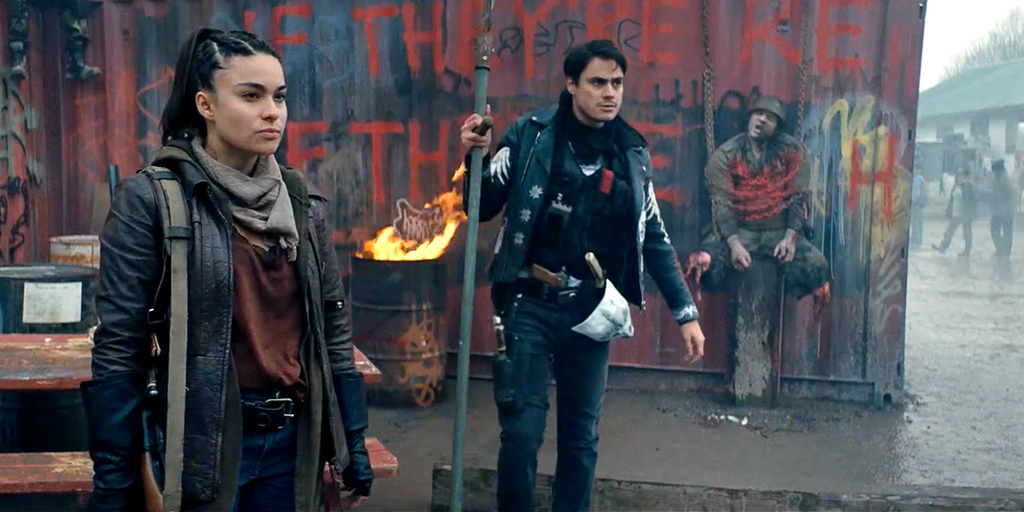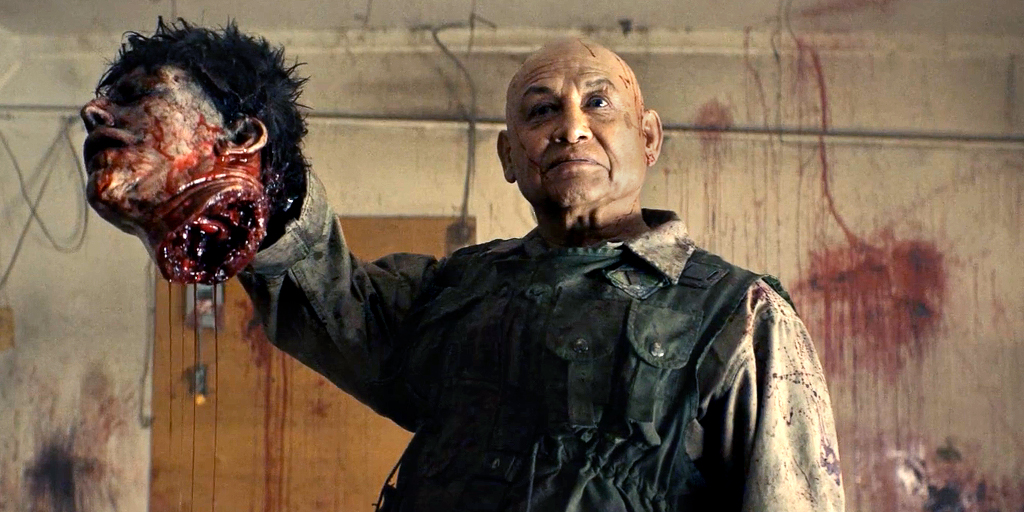REVIEW: Blood Quantum (2019) dir. Jeff Barnaby
Posted by admin on

One of the curious side effects of the Covid pandemic– or any all-consuming news story– is the way it transmogrifies the way we consume pop culture. Suddenly, the most innocuous party or crowd scene takes on an uncanny air, and any reference to disease or contagion, no matter how glibly intended, hits like a ton of bricks (I remember a similar effect in the months following 9/11, when even something as inconsequential as the American flag hanging in Donnie Darko’s bedroom suddenly felt fraught with meaning). This, of course, becomes doubly true when a text actually has something to say about the subject. We’ve already seen this with the excellent Bacurau, whose already-relevent tale of governmental neglect and low-income revenge felt ripped from the headlines when it dropped in the early weeks of the quarantine. Likewise, when Jeff Barnaby’s indigenous-driven zombie thriller made the festival circuit (including the beloved Boston SciFi Film Festival, where it was this year’s closing night selection), its political bonafides were readily apparent. But just a few months later, when daily life more and more closely resembles The Walking Dead and the persecution of communities of color has become even more glaringly obvious, Blood Quantum starts to feel like a film that could only be released at this precise moment– which, thanks to a surprise midnight drop via horror streaming service Shudder, it has.
Set in and around the Red Crow Mi’gmaq reserve in Quebec, Blood Quantum opens with dedicated Sheriff Traylor (Michael Greyeyes) and his family navigating the early days of a rapidly escalating zombie apocalypse. Within 24 hours, Traylor goes from witnessing his father’s freshly gutted fish still flopping hours later in the cooler (a delightfully sick visual) to being inundated with calls of madness, disease, and cannibalism. The action then cuts to six months later: the outbreak, for reasons unknown, is limited to white populations and select wildlife, while indigenous people are immune to reanimation (though not, of course, to being eaten alive). Red Crow has become a fortress, efficiently run by Traylor’s sons, responsible Joseph (Forrest Goodluck) and hotheaded Lysol (Kiowa Gordon). But suspicions toward the camp’s white refugees (including Joseph’s pregnant girlfriend) soon come to a head, causing loyalties to shift– and intestines to spill.

Blood Quantum’s most striking attribute, both before the pandemic and during, is its cast and setting. Films featuring predominantly indigenous talent both in front of and behind the camera are depressingly rare in any genre, let alone the stereotypically white-boys’-club of horror. To see a film in which indigenous culture is explored and celebrated (while never exoticized) is a breath of fresh air, particularly in a context in which it’s only half of the focus. To the citizens of Red Crow, a white population driven by a blind urge to kill and dismember them is merely a literalization of an existing dynamic (in a handy bit of symbolism, one white refugee is taken to task for entering carrying a blanket which had belonged to an infected loved one). The title, incidentally, refers to the horrifying American policies still on the books which determine indigenous rights based on percentage of lineal descent. To white Americans, the idea of being cordoned off from society by malevolent forces bearing unknown viruses is the stuff of horror movies; to indigenous Americans, it’s a history lesson.
Of course, Blood Quantum is a horror movie as well, and a cracking good one. Independent horror movies in general, and zombie movies in particular, need to walk a delicate line between dour unpleasantness and obnoxious in-jokiness, and while Blood Quantum occasionally drifts into ponderous Walking Dead territory, Barnaby keeps the proceedings moving with deft energy. Much of this is thanks to the satisfyingly gruesome effects, playfully deployed and, crucially, almost entirely practical (too often these days do low-budget filmmakers try to skimp on corn syrup with garish CGI blood splatter). But Barnaby also shoots with a panache that one does not always see in this realm, showing off his chilly Canadian locations with bravado and confidence.
There are times, to be sure, when Blood Quantum falls victim to its budgetary limitations (there is an economy of locations which becomes apparent even in flashbacks), and the pacing is occasionally a little wobbly; in particular, the flash-forward at the end of the first act is jarring, and would have benefited from either a truncated prologue or a scene or two showing society’s descent into chaos. But such concerns are trifling in the face of a scrappy little film with this much soul, brain, and heart. Like the slasher, the zombie siege film is by its nature formulaic, and lives or dies (or, uh, lives again) by whether the filmmakers have something to say. To this end, Blood Quantum succeeds with flying colors, presenting a cast of characters you’ve almost certainly never seen in a genre film before and and a range of social commentary that goes beyond the Romero playbook (a slogan spraypainted on the camp’s gates reads “IF THEY’RE RED, THEY’RE DEAD / IF THEY’RE WHITE, THEY BITE”). Astoundingly, according to the film’s press notes, Blood Quantum is the most expensive indigenous-made film ever made in North America, and possibly the world. I have little doubt that Barnaby will break this record again in due time.
Blood Quantum
2019
dir. Jeff Barnaby
97 min.
Now streaming on Shudder (free 30-day trial with code SHUTIN)
Streaming is no substitute for taking in a screening at a locally owned cinema, and right now Boston’s most beloved theaters need your help to survive. If you have the means, the Hassle strongly recommends making a donation, purchasing a gift card, or becoming a member at the Brattle Theatre, Coolidge Corner Theatre, and/or the Somerville Theatre. Keep film alive, y’all.
The post REVIEW: Blood Quantum (2019) dir. Jeff Barnaby appeared first on BOSTON HASSLE.
